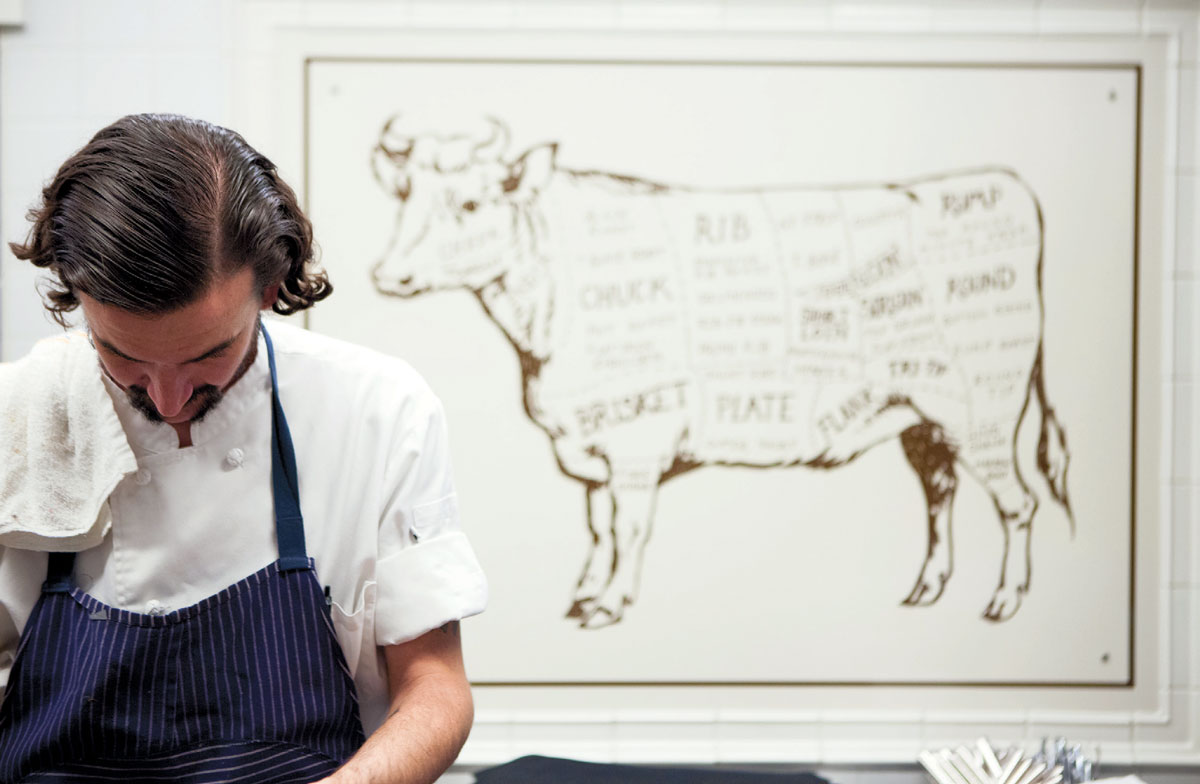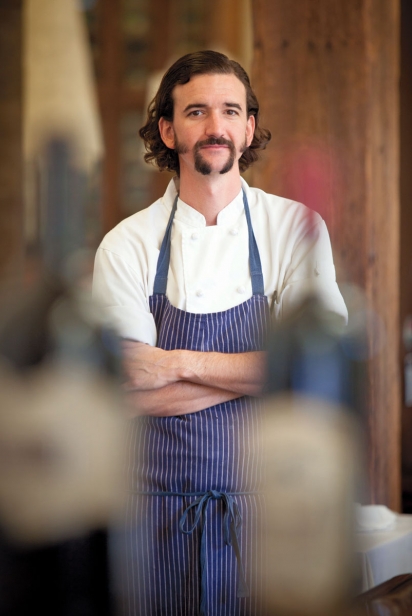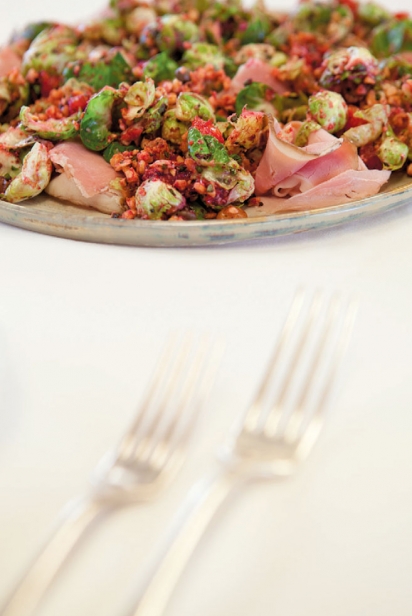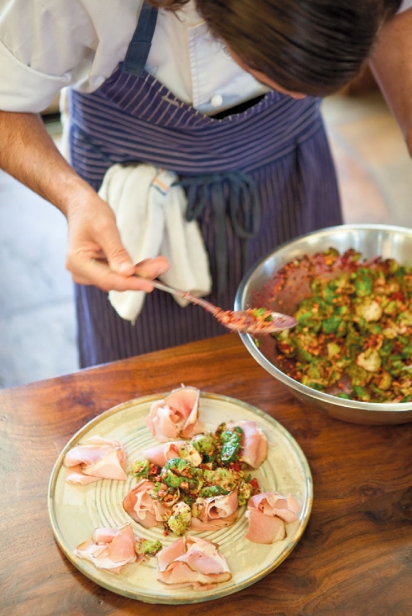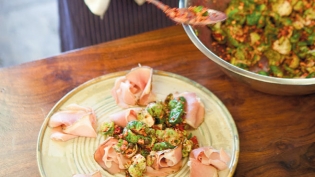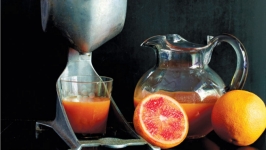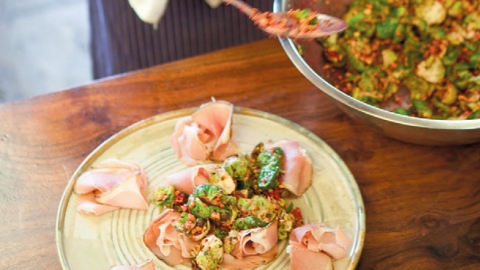A More Sustainable Steakhouse
Trevor Kunk of Press is on the job.
At first glance, the menu at a traditional steakhouse—beef, creamed spinach and potatoes—could be confining to a chef, but since the arrival of Executive Chef Trevor Kunk moments before the 2014 Napa earthquake, St. Helena’s Press has pushed the paradigm of what a steakhouse offers its patrons. Fueling Kunk’s creative fires is his passion for sustainable, seasonal cooking and eating. Even in winter. Even in Northern California. Even spinach.
Kunk, a 2003 graduate of the Culinary Institute of America in Hyde Park, New York, developed his culinary chops first under Charlie Palmer at New York City’s Aureole. During his internship at Aureole, Kunk, who was raised in Florida, fell in love with New York and sought to return to the city after graduation. He did go back to Aureole for a time, but soon found a long-term home in the kitchen with renowned chef Dan Barber at Barber’s Blue Hill New York City.
Barber first earned acclaim as Food and Wine magazine’s Best New Chef in 2002 for his work as executive chef and co-owner (with his brother, David, and David’s wife, Laureen) of Blue Hill. Since then, Barber’s stature as the “East Coast Alice Waters” (they share a passion for local, sustainable, ethically raised and produced food) has solidified further. His second restaurant, Blue Hill at Stone Barns, is on the Rockefeller Estate in Westchester County, New York, where Barber also helped develop a thriving farm that, through its Center for Food and Agriculture, serves as a research and training center for sustainable restaurant and farm management.
Kunk began at Blue Hill as a tournat, one of the first roles in the hierarchy that makes up a kitchen brigade. “I worked every station,” says Kunk, “garde manger, pastry, entremetier … Dan really created the position for me.” Under Barber’s tutelage, Kunk gradually moved up through the ranks to sous-chef and, eventually, chef de cuisine, a position he held for seven years.
“We constantly grew together. If we were not making changes, we were not getting better. It was an amazing place to be,” says Kunk.
Kunk credits Barber’s management style of constant sharing and the ability of any staff member to ask questions with making his cooking more dynamic. “You get to learn the story behind everything,” Kunk says. “It makes what you are doing more exciting and provides context.”
With Barber, Kunk learned that the most important thing about cooking was the ingredients: Source the best ingredient, then taste it before deciding how to cook it. He learned to cook for the ingredient. And that the best ingredients were found in the local foodshed, harvested in the season that was right for that ingredient.
They were clearly on to something—Blue Hill was the winner of the 2013 James Beard Award for Outstanding Restaurant.
After 10 years at Blue Hill, Barber, ever the mentor, inquired if it might be time for Kunk to move on, time to spread his wings. Kunk says he was ready to leave New York and embrace a new form of seasonality, the eternal green of California.
In New York, where winters are notoriously long and the summers brutally short, the small windows for fresh ingredients often meant a deluge of one ingredient in a short period of time. This spurred the Blue Hill team’s creativity: How many ways can this asparagus appear on the menu before its short six-week season ends?
“Here [in California], you can run one variety out on a salad, then change the salad again before the season for that ingredient runs out,” says Kunk. “There is the creative space to change within a season.”
Shortly after his move west, Kunk drove south through Monterey and witnessed the sprawling green fields of broccoli, artichokes and strawberries. “I realized you can grow anything here [in California] at any time,” he says. “It might be local, but is it the best ingredient I can find?”
Take spinach. Creamed spinach, like potato fries, are staples on Press’ menu year-round. So how to make sure it’s not just any spinach? Kunk looks to Rudd Farms on Napa’s Mount Veeder. The 13-acre organic farm is owned by Leslie Rudd, who is also the owner of Press, as well as Oakville Grocery with locations in Oakville and Healdsburg. Nice connection.
Living and working in the heart of America’s salad bowl has encouraged Kunk to explore the non-meaty aspects of the steakhouse’s menu more deeply. Sure, there is a chopped salad with Point Reyes Farmstead’s blue cheese and California state-mandated avocado. (I kid.) But Kunk’s new vegetable cocktail that tops the menu has become a local favorite. The vegetables change with the season, as does the seasonal emulsion that accompanies it. During winter, guests might experience bacon butter or a kimchi emulsion as a dip for ice-cold raw vegetables. An entrée of grilled cucumber and eggplant is so popular, Kunk is playing around with pickling the cucumbers in order to keep the dish on the menu through the (fingers crossed) rainy season.
In another nod to his mentor Barber—who recently drew worldwide attention and acclaim when he launched “Wasted,” a program to reduce and repurpose food waste in the restaurant food chain—as little as possible is wasted in the Press kitchen. Rudd Farms carrots are steamed with aromatics, grilled and glazed with burnt honey, curry, black pepper and finished with lime juice. Rather than throw away the pressed lime rinds, Kunk dries them until brittle, bakes them until they blacken and grates lime shavings over the finished dish. He calls it “carbonized lime,” but you can call it a thoughtful addition to a deeply flavorful dish that reimagines how to use a lime rind that would otherwise have been tossed.
Carrying on the traditions of constant growth and evolution, Kunk continues to build more sustainability, more seasonality, into his menu. Proteins are the next natural target. Kunk makes no bones about the whole Maine lobster and jumbo shrimp on Press’ seafood platter. It’s a steakhouse and those are standard fare. Salmon, however, gets a deeper look.
“There are only two farms that are certified by the Monterey Bay Aquarium’s [Seafood Watch] sustainable seafood program,” says Kunk. When wild salmon is not in season and salmon from those two farms is not available, salmon is removed from Press’ menu. Kunk recently began working with Passmore Ranch near Sacramento, bringing in their sturgeon, trout and bass. “It is not only a product we want to support, but a product we want to serve,” says Kunk.
During his time with Barber, Kunk learned that beef, the beating heart of a steakhouse’s menu, also has a season. Press sources its traditional steakhouse cuts from Brian Flannery of San Francisco–based Flannery Beef. For the 100% grass-fed beef it offers, Kunk relies on Bill Niman, founder and former owner of Niman Ranch and current owner of BN Ranch. Niman, recognized for his commitment to sustainable beef, sources only in-season, grass-fed beef, which means sometimes looking outside the local foodshed.
“Historically,” Niman says, “the availability of grasses determined when the slaughter season was.” Cattle farmers, with consideration to calving and to the best-performing animals, sought to kill an animal within two weeks of optimal grazing conditions. “That is true no matter where you are in the world,” says Niman. In Northern California, in years when there is not drought, that usually means harvesting an animal sometime between April and June, when coastal animals have peak grasses, and October through December for animals that feed on irrigated grass in the Sacramento delta region.
That schedule can be difficult for restaurants to adhere to, especially when customers demand prime cuts for the holidays and other special occasions. Rather than turn to cattle that are slaughtered out of season, kept in feedlots and fed feedlot rations until slaughter (another story for another time), Niman began to look elsewhere for seasonal, meaning grass-fed, beef. Niman went around the world, across Canada, Argentina and New Zealand, before partnering with ranchers in New Zealand and Alberta, Canada.
“If you want good grass-fed beef,” Niman says, “you have to eat it in season.” New Zealand and Argentina have rain and, therefore, grass all year. Niman sources New Zealand beef during their summer months, approximately mid-December through March. Western Canada’s grasses peak in summer, roughly July through October. “In seasonal beef, the locale is more important than local,” says Niman. He ages his beef 45 to 60 days at a minimum before it is sent to Press. Perhaps not surprisingly, Niman also supplies seasonal beef to Barber’s Blue Hill.
“Something eaten in season tastes the best,” reiterates Kunk, who recommends subscribing to a community-supported agriculture (CSA) program as the surest way to source super-fresh, abundantly flavorful food. Search out grass-fed beef from the best in-season locale (note the “e”) and fish from purveyors who adhere to the Monterey Bay Aquarium’s Seafood Watch program. No system is perfect, but by following these guidelines you’ll be well on the path to ensuring that the foods on your table this winter, as well as in summer, will be at their most sustainable, most flavorful best.


